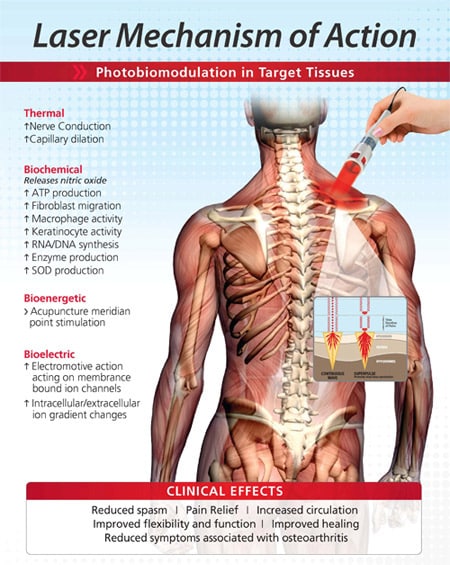Laser therapy, a novel approach to pain management, has carved out a niche in the vast array of medical treatments available today. Individuals suffering from a variety of painful conditions can benefit from this non-invasive solution, which is known for stimulating the body’s innate healing mechanisms. Let us delve deeper into the principles of laser therapy, investigating its scientific foundation, benefits, and inherent limitations. At our renowned facility in Brooklyn, New York, the Pain Therapy Medical Care offers advanced pain therapy services, including laser therapy for pain management, which can provide a highly effective, non-invasive solution for managing a variety of pain conditions.
The Science Behind Laser Therapy
Understanding the principles of laser therapy necessitates a fundamental understanding of its key mechanism, the role of light wavelengths, and how these factors interact to deliver the therapy’s benefits.
Low-Level Laser Therapy (LLLT): The Basic Mechanism
LLLT, also known as cold laser therapy, stimulates the body’s natural healing processes by using specific light wavelengths that penetrate the skin. The laser light first reaches the mitochondria, the cellular organelles responsible for energy production.
When exposed to this light, mitochondria increase their production of adenosine triphosphate (ATP), the fundamental molecule that transports energy within cells. This increase in ATP production promotes cellular repair and growth by triggering an enhanced healing response. This, in turn, contributes to a decrease in inflammation and pain, which is the primary goal of laser therapy for pain management.

The Importance of Wavelengths in Laser Therapy
Light wavelengths are critical to the efficacy of laser therapy. The wavelength chosen determines how deeply the laser light can penetrate body tissues. For superficial tissue penetration, wavelengths between 600 and 700 nanometers are commonly used. In contrast, wavelengths ranging from 780 to 950 nanometers can reach deeper structures within the body. Because of this, these wavelengths are particularly effective for treating pain in deeper tissues, such as back and knee pain.
The Real-World Advantages of Laser Therapy
One of the most significant advantages of laser therapy is that it is non-invasive. Because of this, laser therapy is an appealing option for patients who are hesitant about surgical interventions or who have health conditions that make invasive procedures unsuitable.

There is no downtime with laser therapy
Laser therapy, unlike surgical procedures, does not necessitate lengthy recovery times. Patients can usually resume their normal activities immediately following a session. As a result, it is an excellent choice for those who cannot afford extended periods of rest or inactivity due to work or personal obligations.
- Laser Therapy Has a Wide Range of Applications
- Laser therapy has been used to treat a wide range of conditions
- Back and knee pain effectively managed
Laser therapy, particularly when used with deep penetrating wavelengths, can be an effective treatment option for chronic back and knee pain.
Focusing on the source of the pain, aids in healing the affected area and restoring range of motion, significantly improving patients’ quality of life.
- Recognizing Laser Therapy’s Limitations
- Despite its numerous advantages, it is critical to recognize that laser therapy has limitations
- Laser Therapy’s Variable Effectiveness
While laser therapy is generally beneficial, its effectiveness varies depending on the specific condition and treatment parameters used. It’s important to remember that in some cases, such as lumbar disk herniation-related low back pain, LLLT may not outperform a placebo.
Applicability Considerations and Research Limitations
While the basic concept of laser therapy is well understood, ongoing research is being conducted to improve its applicability to various conditions and the optimal parameters for its effective use.
Factors affecting accessibility and cost
Although laser therapy is becoming more popular, access may still be an issue in some areas, and the costs associated with this treatment may be prohibitive for some patients. Furthermore, not all insurance policies cover laser therapy, complicating access to this treatment even further.
Laser Therapy’s Future Prospects in Pain Management
As we progress through the realm of medical advancements, it becomes clear that treatments such as laser therapy will play an increasingly important role in the future of pain management. Technological advancements continue to improve its precision, effectiveness, and safety, making it a beacon of hope for people suffering from chronic pain.
The challenge, however, is to make laser therapy more accessible and affordable to a larger population. Overcoming this barrier would necessitate a collaborative effort on the part of healthcare providers, insurers, and policymakers. In the coming years, insurance policies may change to include laser therapy and other innovative non-invasive treatments, making them more accessible to those in need.
The versatility of laser therapy adds to its potential. Its current applications range from musculoskeletal conditions such as back pain and knee pain to post-surgical pain relief and wound healing. The adaptability of laser therapy allows it to be used to manage pain associated with a wide range of other conditions. However, more research is needed to determine its efficacy and define the parameters for its optimal use in these various conditions.
Furthermore, the prospect of combining laser therapy with other treatment modalities is enticing. It has the potential to improve the overall effectiveness of pain management strategies when used in conjunction with treatments such as platelet-rich plasma (PRP) therapy or electromagnetic transduction therapy (EMTT).
In-Depth Analysis of Laser Therapy for Pain Management: The Science, Benefits, and Limitations – Summary
To summarize, laser therapy is an exciting new pain management option that combines scientific innovation, therapeutic effectiveness, and patient convenience. Despite some limitations, its potential to revolutionize pain management remains enormous. As we work to better understand this promising tool, it is clear that laser therapy will continue to pave the way for a future with effective and accessible pain management solutions.
Remember, as with any medical treatment, it is critical to consult with your healthcare provider or a pain management specialist to determine whether laser therapy is the best treatment option for you. The Medical Pain Management facility in Brooklyn, New York City, is at the forefront of pain management innovations, including laser therapy. We invite you to investigate these treatments as part of your quest for a pain-free life.




